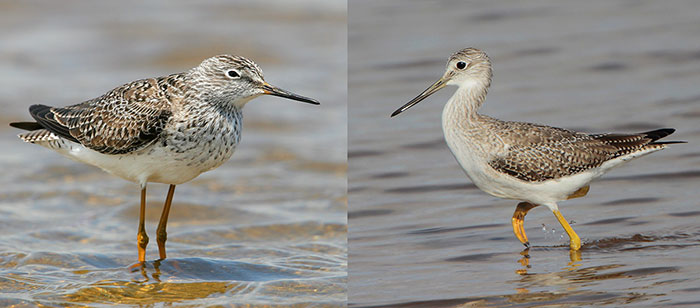
There are two yellowleg species regularly found in the United States and Canada. Both species nest in northern Canada and into Alaska. Both migrate south in the winter to all three coasts and into Mexico. The Great Yellowlegs is more widespread in the winter, but both species are generally common during migration and in their winter ranges.
These two long-legged shorebirds can be easy to confuse with each other, and with at least one other species. They are very similar in appearance but can be told apart with a little experience
On this page
Lesser Yellowlegs
Lesser Yellowlegs are Killdeer-sized sandpipers, but with long legs that can sometimes be covered in mud. The is bill slightly longer than its head. Most winter in the Tropics. In April they begin to show back up in small flocks as the fly around the Gulf of Mexico, not across it.
A small flock of feeding yellowlegs almost always Lesser and not Greater Yellowlegs. The call is usually one or sometimes more “teewee” sounds, usually of the same pitch.
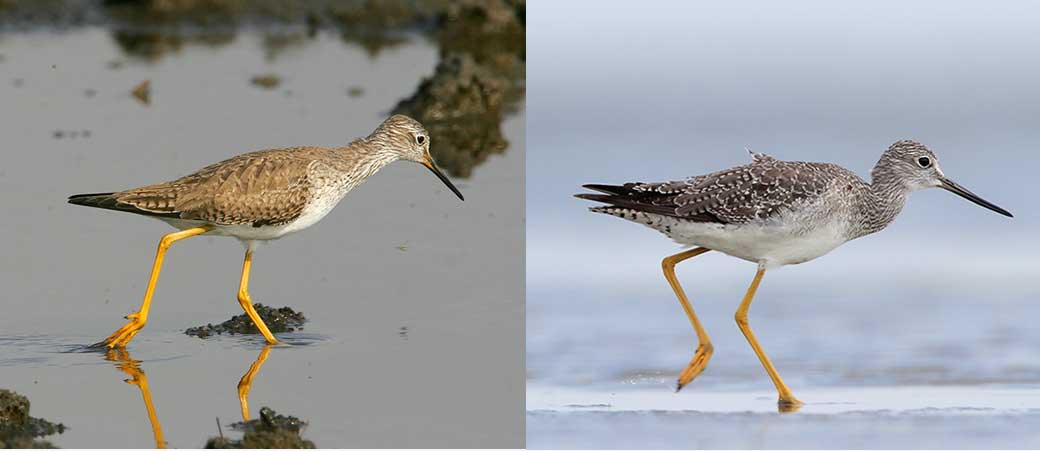
Lesser yellowlegs (left) and greater yellowlegs (right)
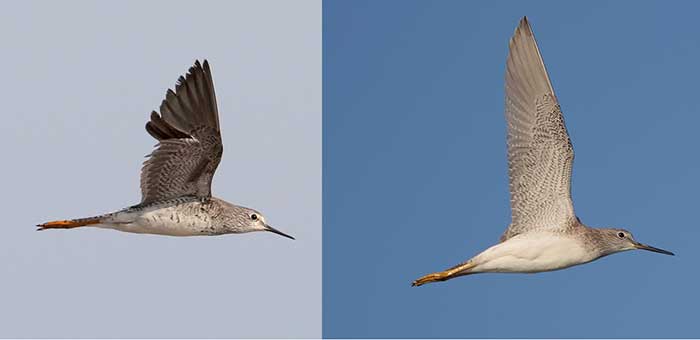
On flight: Lesser yellowlegs (left) and greater yellowlegs (right)
Greater Yellowlegs
Greater Yellowlegs are closer in size to the Willet, but isolated birds can be difficult to identify based on size.
They are easier to identify based on their features – Greater Yellowlegs have a bill that is about twice the length of its head, and sometimes shows a slight upward curve. It tends to be more heavily barred than the lesser and tends to be loner. The call of the Greater is much stronger than the Lesser, usually 3 or more descending notes.
Comparing the two
In terms of size, Greater Yellowlegs are larger than their lesser counterparts, with a noticeable difference in bill length. The bill of the Greater Yellowlegs is longer and slightly upturned, whereas the Lesser Yellowlegs has a shorter and straighter bill.
The plumage of both species is quite similar, featuring a mottled brownish-gray appearance on their upper parts and a white underbelly. During the breeding season, both birds may exhibit more vibrant and distinct markings, but these are subtle and may not be easily distinguishable in the field.
One key feature for differentiation is their size, with the Greater Yellowlegs being noticeably taller. This size contrast becomes more evident when the birds are seen together or in relation to other shorebird species.
Additionally, the vocalizations of the two species differ but are difficult to tell apart.
Location & Behavior
Both species are found near wetlands and marshes, where they like to catch aquatic invertebrates. During the breeding season, both yellowlegs are looking for wetter areas, such as woodlands with some ponds or bogs. Greater and Lesser Yellowlegs both nest on the ground. Once the chicks hatch and are old enough, parents introduce them to their surroundings.
When it comes to their behavior, they are not too different either. When looking for food, they walk slowly and deliberately, while using their bills to probe and feel movements. Lesser Yellowlegs are more social than their bigger counterparts, and can sometimes form looser flocks. Greater Yellowlegs are quite solitary and might only froup together for migrating.
More Similar Species
Solitary Sandpipers look incredibly similar to both Yellowlegs, although they do not have the signature ‘yellow legs’ that Lesser and Greater Yellowlegs are named after.
Otherwise, Yellowlegs look fairly similar to other shorebirds, such as other sandpipers, curlews or stilts. Although they do not look exactly the same, their behaviors and overall appearances aren’t too different.
Lesser Yellowlegs & Greater Yellowlegs side by side
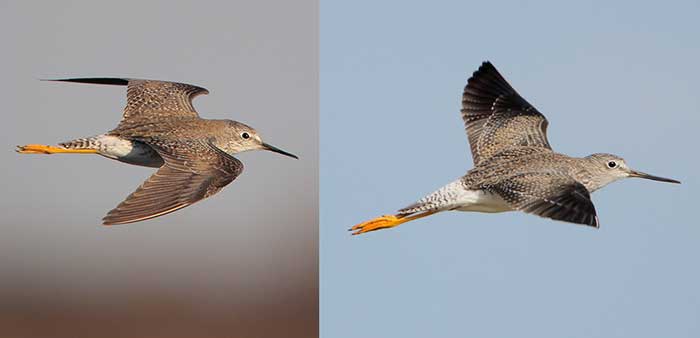
On flight: Lesser yellowlegs (left) and greater yellowlegs (right)
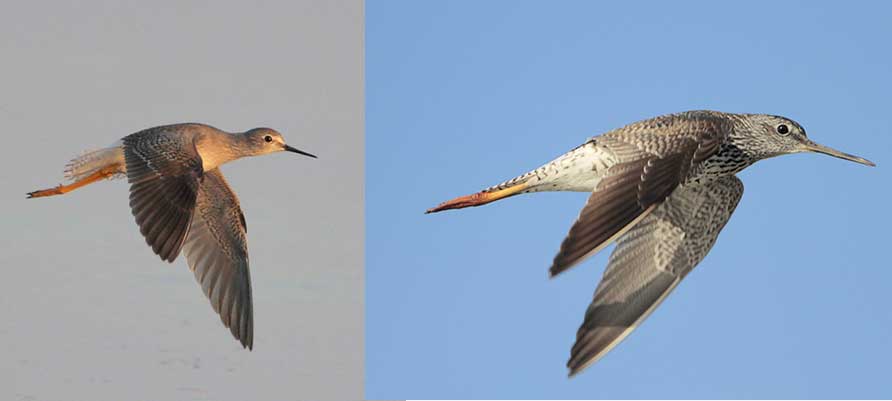
Comparison of greater (left) and lesser-yellowlegs (right) in flight with the wings down
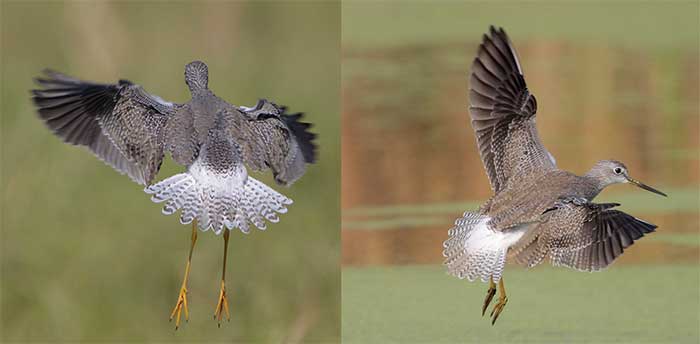
Comparison of greater yellowlegs (left) and lesser-yellowlegs (right) in flight from the back
Greater and Lesser Yellowlegs look pretty much identical, especially if you only see one. Looking at them side by side is much easier, but a good rule of thumb is to look at their legs and bills. Greater Yellowlegs appear much taller, but unless you have some other bird to compare them to, it might get tricky. Lesser Yellowlegs have shorter legs and bills (around as long as their heads).
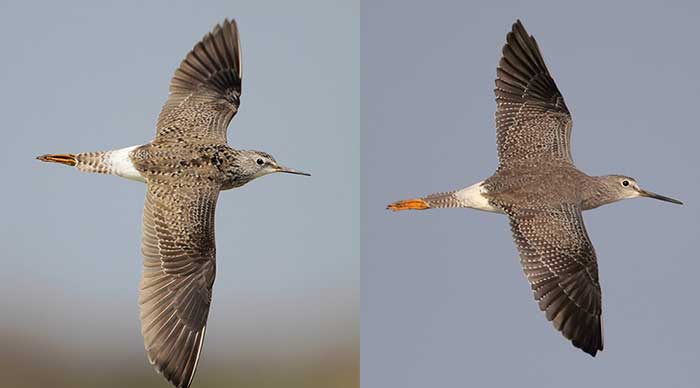
comparison of greater (left) and lesser-yellowlegs in flight, from the side
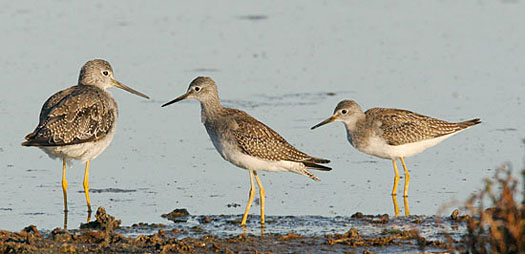
The above photo shows both yellowleg species. The bird on the left is the Greater Yellowleg. The two birds on the right are Lesser Yellowlegs.
Note the shorter, thinner and more pointed bill of the Lesser. As the name suggests, the Greater Yellowlegs is the larger of the two species, but size can be confusing unless there is a comparison with another species.
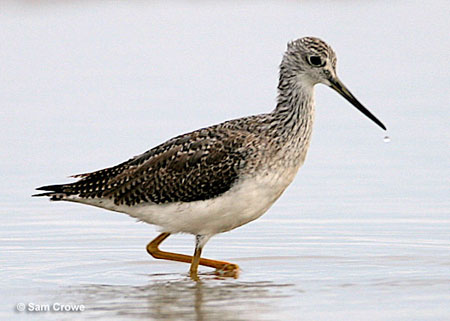
The bill of the Greater Yellowlegs is sometimes slightly curved upward, a feature not shown well in this image of a Greater Yellowlegs. In winter-plumaged birds, the bill is two-toned.
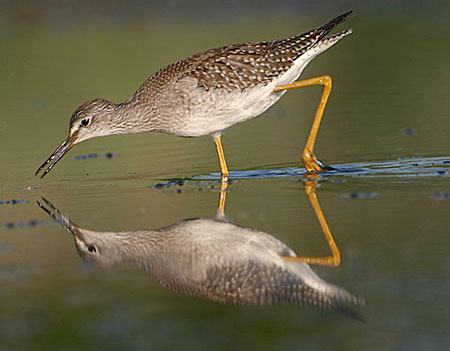
The bill on this Lesser Yellowlegs is thin and straight. Lesser Yellowlegs have a slightly less robust appearance the Greaters.

